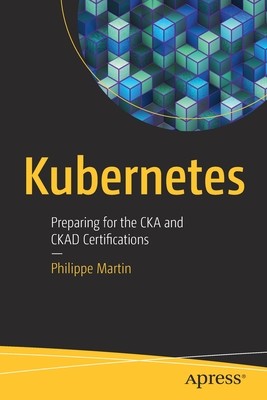
- We will send in 10–14 business days.
- Author: Philippe Martin
- Publisher: Apress
- ISBN-10: 1484264932
- ISBN-13: 9781484264935
- Format: 15.6 x 23.4 x 1.4 cm, softcover
- Language: English
- SAVE -10% with code: EXTRA
Reviews
Description
Chapter 1: Creating a Cluster with kubeadm- Provisioning Compute Resources- Install Docker on the hosts- Install kubeadm, kubelet, and kubectl on the hosts- Initialize the control plane node- Join the workers
Chapter 2: Control Plane Components- Explore the Control Plane services
Chapter 3: Accessing the Cluster- Install kubectl on your dev machine- Access the cluster from the dev machine
Chapter 4: Kubernetes Resources- Namespaces- Labels and selectors- Annotations
Chapter 5: The Workloads- Pod specs- Container specs- Pod controllers- ReplicaSet controller- Deployment controller- Update and rollback- Deployment strategies
Chapter 6: Configuring Applications- Arguments to the command- Environment variables- Configuration file from ConfigMap- Configuration file from Secret- Configuration file from Pod fields- Configuration file from container resources fields- Configuration file from different sources
Chapter 7: Scaling an Application- Manual scaling- Auto-scaling
Chapter 8: Application Self-Healing- Controller to the rescue- Liveness probes- Resource limits and quality of service classes
Chapter 9: Scheduling Pods- Using label selectors to schedule pods on specific nodes- DaemonSets- Static pods- Resource requests- Running multiple schedulers
Chapter 10: Discovery and Load Balancing- Services- Services types- Ingress
Chapter 11: Security- Authentication- Authorization- Security contexts- Network policies- Working with private Docker registries
Chapter 12: Storage- Persistent volumes- Claiming a persistent volume- Using auto-provisioned persistent volumes
Chapter 13: Monitoring and Logging- Basic logging
Chapter 14: Upgrading the Cluster- Upgrade the controller- Upgrade the workers- Upgrading the operating system- Backup a cluster- Restore a cluster
Chapter 15: kubectl- Managing kubeconfig file- Generic commands- Creating applications resources- Managing clusters- Getting documentation
A. Curriculum CKA
B. Curriculum CKAD
EXTRA 10 % discount with code: EXTRA
The promotion ends in 18d.18:00:34
The discount code is valid when purchasing from 10 €. Discounts do not stack.
- Author: Philippe Martin
- Publisher: Apress
- ISBN-10: 1484264932
- ISBN-13: 9781484264935
- Format: 15.6 x 23.4 x 1.4 cm, softcover
- Language: English English
Chapter 1: Creating a Cluster with kubeadm- Provisioning Compute Resources- Install Docker on the hosts- Install kubeadm, kubelet, and kubectl on the hosts- Initialize the control plane node- Join the workers
Chapter 2: Control Plane Components- Explore the Control Plane services
Chapter 3: Accessing the Cluster- Install kubectl on your dev machine- Access the cluster from the dev machine
Chapter 4: Kubernetes Resources- Namespaces- Labels and selectors- Annotations
Chapter 5: The Workloads- Pod specs- Container specs- Pod controllers- ReplicaSet controller- Deployment controller- Update and rollback- Deployment strategies
Chapter 6: Configuring Applications- Arguments to the command- Environment variables- Configuration file from ConfigMap- Configuration file from Secret- Configuration file from Pod fields- Configuration file from container resources fields- Configuration file from different sources
Chapter 7: Scaling an Application- Manual scaling- Auto-scaling
Chapter 8: Application Self-Healing- Controller to the rescue- Liveness probes- Resource limits and quality of service classes
Chapter 9: Scheduling Pods- Using label selectors to schedule pods on specific nodes- DaemonSets- Static pods- Resource requests- Running multiple schedulers
Chapter 10: Discovery and Load Balancing- Services- Services types- Ingress
Chapter 11: Security- Authentication- Authorization- Security contexts- Network policies- Working with private Docker registries
Chapter 12: Storage- Persistent volumes- Claiming a persistent volume- Using auto-provisioned persistent volumes
Chapter 13: Monitoring and Logging- Basic logging
Chapter 14: Upgrading the Cluster- Upgrade the controller- Upgrade the workers- Upgrading the operating system- Backup a cluster- Restore a cluster
Chapter 15: kubectl- Managing kubeconfig file- Generic commands- Creating applications resources- Managing clusters- Getting documentation
A. Curriculum CKA
B. Curriculum CKAD


Reviews